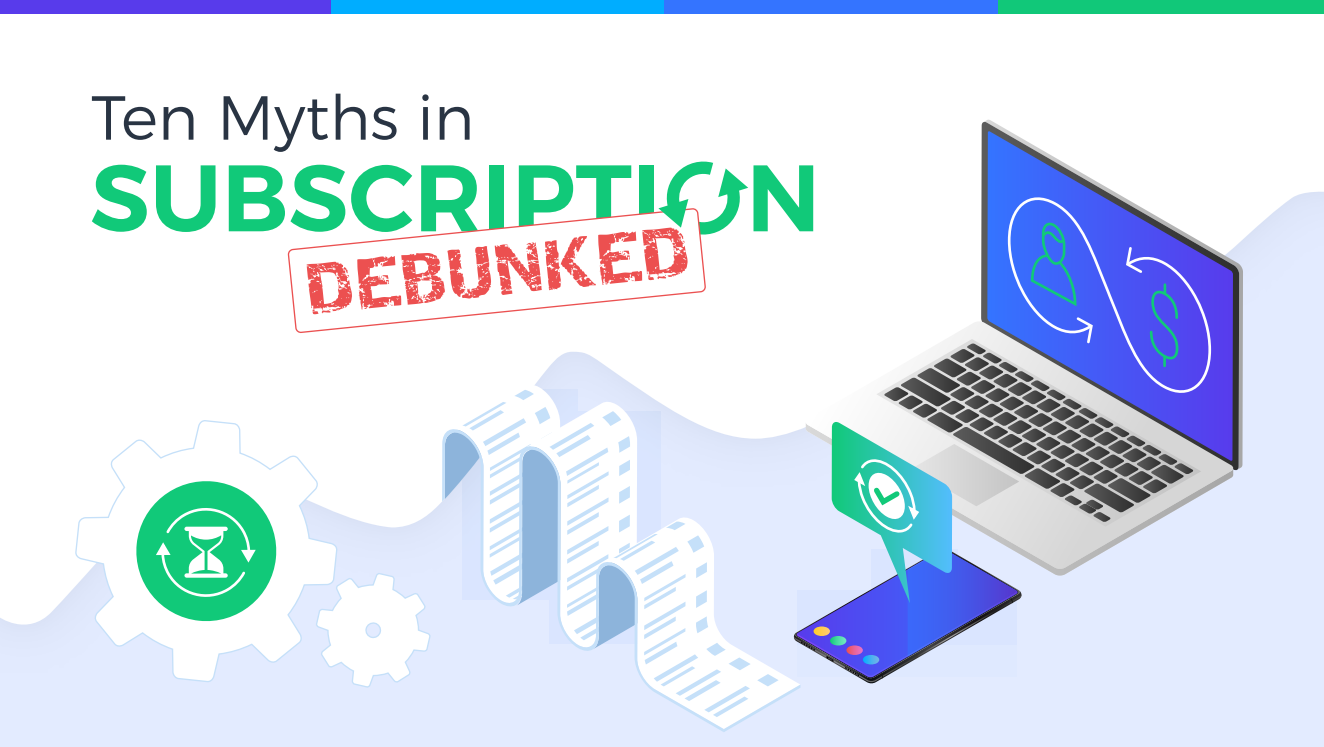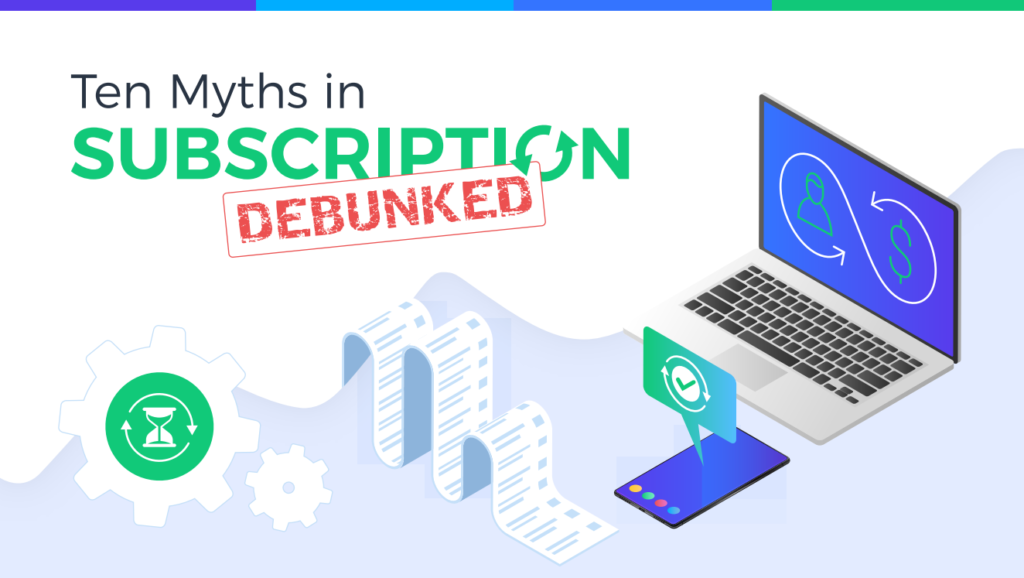If the idea of following a subscription monetization model for your company sounds scary, we’re here to tell you there’s nothing to be afraid of. A bunch of myths shouldn’t hold you back — especially when you have the arguments to disprove them. While the subscription model has already been readily adopted by SaaS companies, its applicability goes beyond services and software.
There’s plenty of room for eCommerce to join in on the excitement, and the advantages of customers paying at regular, recurring intervals for a product or service. It takes some work to change growth models, but there is a huge upside to doing it.
We are going to take some common subscription myths head-on so you don’t miss out.
Myth #1: Subscription growth is just hype
Whoa! Whoever said this hasn’t looked at the data! In fact, there’s been a rather extreme growth in subscriptions. McKinsey reported that eCommerce subscriptions have grown more than 100% annually from 2013-2018. And Gartner says that, by next year, more than 80% of software vendors will make the shift to a subscription-based model.
Customer expectations have shifted, and people now prefer renting rather than purchasing, which encourages this model. People and businesses alike want flexibility. They want nothing less than to be caught with something outdated. Renting or subscriptions address this threat head-on.
Myth #2: It’s hard to manage subscriptions
Managing subscriptions does require a lot, but it is something many businesses all over the world already successfully achieve. Think of subscriptions as the management, billing, and payment trifecta. You have to set up multiple license options, pricing, customer lifecycle operations such as trials, activations, billing and monetization, upgrades and downgrades, renewals, refunds, and mid-cycle subscription changes.
The right tools can help you manage all these, though. Find a tool to help you manage lifecycle operations and subscriptions, one that integrates with the other solutions employed by your business. For example, you may be using QuickBooks for tracking payments, Zendesk for managing requests, SalesForce to keep an eye on overall account health, and Slack to chat with your customers directly.
A good subscription management tool, like the one included in 2Checkout’s monetization platform, will make a subscription model feasible for you. It can manage sales across channels, amend contracts, prorate or terminate subscriptions, extend trials, give partial refunds, provide billing discounts, give a grace period, and handle updates to credit card information.
Myth #3: Acquisition is as important as retention for growth
Actually, the truth is that acquisition is important, but retention is often more important, especially in the subscription industry. Bain & Company reported that increasing customer retention by 5% can increase your company’s profitability anywhere from 25 to 75%. Which makes sense, given that retention brings in recurring revenue, for each new renewal period. What’s more, the cost of retaining customers is usually lower than that of acquiring them – it can cost you five times more to acquire a new client than to keep an existing one.
Apart from it’s impact on your company’s bottom line, retention also has other, indirect beneficial effects. Retained customers, whom you’ve managed to make loyal to your brand, tend to spend more money and they also have the premise of becoming your brand advocates, helping you win more clients and therefore increasing your growth.
Myth #4: Once you start selling subscriptions with a payments provider you are stuck with them
Good news! Payment data is not owned by you or the provider you use. If being locked in with a payment provider is something that concerns you, you can inform yourself regarding the terms in your contract on payment data transfer.
For the most part, this shouldn’t be a problem, though. If you do face any communication or cooperation problems with your payment provider, you can launch an early renewal campaign with your customers to get them set up in the new payment provider system.
Myth #5: It’s hard to transition from a lifetime license to a subscription-based business or SaaS
Transitioning from one thing to another, no matter what it is you’re transitioning to or from, can be a challenge. But having a plan makes everything doable. There are a few different things you can consider in order to make the transition easier on everyone — employees and customers.
- Think about what you can do to make this transition smooth. You don’t want any changes you make to startle customers or make them feel unsettled. Give them a choice between different options or consider offering trials, for example.
- What pricing structure best suits your company and customers? Is it a flat rate or usage-based? Hybrid of structures? Freemium? Trial? Decide on the best fitting pricing model and between offering monthly or yearly subscriptions.
- What type of packaging and positioning works best for new products? Only give access to what was bought and solely for the time acquired by subscribers, to minimize spillage.
- What tools will you use to manage the subscription lifecycle? Trial, sign-up, upgrades and downgrades, renewals and cancellations. Ensure you make this transition effortless for consumers, by employing the proper subscription management tools.
- What metrics will you track? Every business is different so choose the metrics that will provide the most value without taking too much of your time. Is it monthly recurring revenue? Customer lifetime value? Trial conversion rate? Or something else?
Myth #6: Once you start with a subscription price, it’s not a good idea to change it
Subscriptions are one of the easiest, most effective ways to increase revenue per user. In fact, companies that updated their pricing every quarter increased their average revenue per user (ARPU) by almost double the rate of those that didn’t. The more a customer experiences your product, takes the time to use it, and gets their data in there, the more you become valuable to them, which allows you to increase your prices.
The need to transfer all their efforts to another company is just not worth it. They’d rather pay more for their subscription with you than go through all that again. While it’s not necessarily fun to be on the receiving end of price increases, people do understand that costs increase with inflation and prices inevitably go up.
Myth #7: There’s inevitable churn when it comes to subscription renewal
Okay, maybe this is partially true, but there are some things you can do to mitigate voluntary and involuntary churn.
You could be subject to voluntary churn when a subscription is up for renewal for all sorts of reasons. Try these to avoid voluntary churn:
- Send renewal offers and reminders: People like freebies and discounts! It’s hard to stay top of mind when so many things are vying for your customers’ attention, but providing a good offer is a good reason to keep in contact.
- Segment your customers and target them accordingly: The more you can speak directly to someone and their needs, the better. If you have the ideal use case for a certain segment you should definitely be using it.
- Use incentives for keeping auto-renewal on: If auto-renewal is left on then the risk of losing a customer decreases significantly and sales increase significantly. Can you give them access to something you’d normally charge for but doesn’t cost you much if they leave auto-renewal flipped on?
- Put in place migration campaigns from manual to auto-renewal: Through emails, push notifications, and any other methods you have at your disposal, regularly prompt people to turn on auto-renewal.
- Offer grace periods: Maybe someone has just forgotten to renew their subscription. Show you care and give them some extra time. This will keep you from losing a good handful of people.
- Make it easy for customers to disable auto-renew: While your preference is for customers to leave auto-renew on, some will feel much more comfortable if the control is left in their hands and they know they can easily disable the feature if they wish.
- Make your exit path clear: Have a good enough product or service and a high enough confidence that you feel comfortable showing people how they can get out if they want.
- Use customer surveys and other tools to find out why customers churn: Pop-up surveys on your website, surveys by email, and tracking tools that analyze your customers’ behavior will help you understand why you are losing them. Just make sure you are asking just the right questions that you know what to do with the answers you get. If not, the effort ends up being a waste of time.
The worst people to lose are the ones that don’t actually want to leave you! Smart payment tools can help save a lot of those customers.
- Use multi-currency management: increases authorization rates by up to 25%, limits cart abandonment and improves the customer experience.
- Intelligent payment routing: this feature provides automatic support for switching between multiple payment processors around the world.
- Account updaters: an account updater service will record changes to out of date account information and apply them so that payments can still be processed.
- configurable retry logic: recover transactions that only fail temporarily due to soft declines
- Dunning management: use these tool to reduce customer churn and recover lost revenue from failed authorizations
Myth #8: There are simply too many KPIs to keep track of for subscriptions
While there are a lot of KPIs you could track, you need to keep tabs on those that will give you insights into your business’ profitability. Some KPIs look simple, but in reality they are difficult to calculate and follow because some components can be defined in several ways and can be influenced by many variables. The result is that the same metric at the same level can actually mean different things for different companies.
Make it clear what each component means for your business, and be consistent. Some companies keep tabs on churn, MRR, while others on CAC or bookings.
Myth #9: It’s hard to sell subscriptions internationally
This couldn’t be further from the truth and the data doesn’t lie. eCommerce retail sales for 2021 are estimated to hit $4.8 trillion, with 85% of that being outside of the U.S. Nowadays, retail consumers are always seeking confidence and comfort, which means they are already open to buying from international sellers.
Common Sense Advisory discovered in their Can’t Read, Won’t Buy: 2014 study that customers are at least 70% more likely to make a purchase if their shopping cart is in their native language and accommodates their preferred payment method. So, it’s smart to take into account specific areas to ensure an optimized international sales operation.
Applying to specific regions could be things such as the right monetary symbol and language, allowing the most common local payment methods, meeting local tax and compliance requirements, having flexibility in the payment model based on local perception, and using partner management tools to easily fill in the international gaps.
Myth #10: There’s no such thing as selling subscriptions for physical goods
Not only are subscriptions for physical goods feasible, but they are also demanded by consumers. 15% of U.S. online shoppers are enrolled in subscription plans to receive recurring items at their doorstep.
Think: Blue Apron for meals, Dollar Shave Club, Amazon, wine clubs, diaper subscriptions, and more for regularly used items that need replacing and people don’t want to be caught without and don’t want the hassle of having to make a last-minute run to the store for them. Not to mention, people prefer renting things now to avoid maintenance and obsolescence. 57% of adults wish they owned less stuff and want to declutter. Subscriptions for physical goods are just getting hot. Consumers will want more and more to subscribe to physical goods and will be grateful if you present them with the opportunity.
Conclusion
Hopefully, we’ve debunked the 10 most common myths from your mind and have given you the confidence to address them head-on. Increased revenue should be yours shortly!
Check out also the infographic on this topic, for a quick, visual overview:






